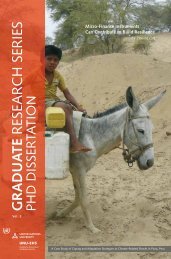Unveiling Women as Pillars of Peace Peace Building in ...
Unveiling Women as Pillars of Peace Peace Building in ...
Unveiling Women as Pillars of Peace Peace Building in ...
You also want an ePaper? Increase the reach of your titles
YUMPU automatically turns print PDFs into web optimized ePapers that Google loves.
B<strong>as</strong>ed on the realisation that cl<strong>as</strong>hes had poisoned relationships beg<strong>in</strong>n<strong>in</strong>g at the household<br />
and extended family levels, the family w<strong>as</strong> the first unit <strong>of</strong> concern. In over half <strong>of</strong> the families<br />
affected, violence perpetrated by members <strong>of</strong> the same family caused <strong>in</strong>ternal displacement. The<br />
picture w<strong>as</strong> more dismal <strong>in</strong> situations <strong>of</strong> <strong>in</strong>ter-ethnic marriages. More than 80 percent <strong>of</strong> such<br />
families experienced a breakdown <strong>of</strong> marriage with spouses or children displaced <strong>in</strong> opposite<br />
directions. <strong>Peace</strong> build<strong>in</strong>g required understand<strong>in</strong>g this dynamic and focuss<strong>in</strong>g on the family before<br />
extend<strong>in</strong>g to the wider society. <strong>Peace</strong> facilitators made calls for calm, forgiveness, and<br />
reconciliation, at the family level. Us<strong>in</strong>g public meet<strong>in</strong>gs and the Church, peace teams called for<br />
forgiveness, reconciliation and encouraged family reunions.<br />
Beyond the family, peace workers sought to re-establish trust among groups such <strong>as</strong> the<br />
women, youth, and political leaders. Their programme focussed on understand<strong>in</strong>g the people’s<br />
concerns. They sought to identify the concerns, perceptions and strengths <strong>of</strong> each group, and<br />
establish how this <strong>in</strong>formation could complement the peace effort. The peace team engaged <strong>in</strong><br />
extensive consultations with displaced persons, the perpetrators <strong>of</strong> violence, and the host<br />
communities. They attempted to avoid stifl<strong>in</strong>g the concerns <strong>of</strong> any group and allow<strong>in</strong>g any<br />
particular section <strong>of</strong> the communities, to dom<strong>in</strong>ate. .<br />
The consultation processes identified the roles and nature <strong>of</strong> participation <strong>of</strong> various<br />
population groups dur<strong>in</strong>g the cl<strong>as</strong>hes. As Tecla expla<strong>in</strong>ed, this w<strong>as</strong> done <strong>in</strong> a slow but systematic<br />
process:<br />
We first spoke to the IDPs <strong>in</strong> camps. They referred us to those who<br />
had ch<strong>as</strong>ed them away. We then went to the other community and we<br />
were referred to the elders. The elders then referred us to the youth<br />
say<strong>in</strong>g that although they had been <strong>in</strong>volved, they no longer had<br />
control over the violence. The youth were <strong>in</strong> control.<br />
Communities were then grouped <strong>in</strong>to four categories b<strong>as</strong>ed on how they would participate.<br />
Youth, women, elders, and politicians became target groups for designated peace activities.<br />
Invit<strong>in</strong>g the Youth to Make <strong>Peace</strong><br />
The youth were a critical group because they are reservoirs <strong>of</strong> violence. Dur<strong>in</strong>g the<br />
conflicts, they formed gangs <strong>of</strong> warriors that perpetrated violence. Most felt bitter, rejected,<br />
misused and betrayed by the architects <strong>of</strong> the violence. The words <strong>of</strong> one young member <strong>of</strong> a<br />
maraud<strong>in</strong>g gang capture this mood:<br />
Everybody now looks at us with the eyes that shout murderers,<br />
murderers, but we were not the ones who planned these th<strong>in</strong>gs<br />
[conflicts]. Some people urged us to get <strong>in</strong>volved. In fact, they<br />
threatened some <strong>of</strong> us, so we had to get <strong>in</strong>volved to save ourselves.<br />
But now everyone else h<strong>as</strong> got <strong>of</strong>f the hook and everybody blames<br />
only the youths... 11<br />
Incre<strong>as</strong><strong>in</strong>g unemployment ma<strong>in</strong>ta<strong>in</strong>ed this population <strong>as</strong> reservoirs <strong>of</strong> violence and their<br />
potential to unle<strong>as</strong>h it <strong>in</strong> the future. Initiation <strong>of</strong> susta<strong>in</strong>able peace therefore depended heavily on<br />
elicit<strong>in</strong>g the support <strong>of</strong> the youth. This realisation encouraged peace builders to reach out to the<br />
youth and br<strong>in</strong>g them <strong>in</strong>to the fold <strong>of</strong> peace build<strong>in</strong>g. They used two methods to embrace the youth.<br />
First, peace workers sought out the op<strong>in</strong>ion leaders among the youth <strong>in</strong> all communities. Tecla<br />
called them “the critical ye<strong>as</strong>t.” They helped peace workers ga<strong>in</strong> access to their peers. One <strong>of</strong><br />
them w<strong>as</strong> a young teacher whom Tecla describes <strong>as</strong> committed to help <strong>in</strong> the resumption <strong>of</strong> normal<br />
40



